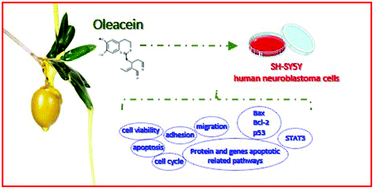Oleacein inhibits STAT3, activates the apoptotic machinery, and exerts anti-metastatic effects in the SH-SY5Y human neuroblastoma cells
Abstract
Several studies published in the last decade suggest that the beneficial role of extra-virgin olive oil (EVOO) in human health is mostly attributable to the main secoiridoid derivatives (oleuropein, oleocanthal, and oleacein). Anti-cancer properties have also been demonstrated for certain compounds present in small quantities in EVOO, including oleuropein and hydroxytyrosol, which have been extensively studied, while minor attention has been given to the most abundant secoiridoid oleacein. The aim of our research was to study the molecular mechanisms underlying the anti-proliferative and anti-metastatic capacity of oleacein in the SH-SY5Y human neuroblastoma cell line. Our results demonstrate that oleacein is able to reduce the proliferation of the SH-SY5Y cells by blocking the cell cycle in the S phase and inducing apoptotic cell death through the increase in both Bax and p53 as well as a reduction in the Bcl-2 expression and STAT3 phosphorylation. Moreover, oleacein caused reduction in the SH-SY5Y cell adhesion and migration. Overall, these findings indicate that oleacein exerts anti-cancer effects against neuroblastoma cells, suggesting a promising role as a candidate against this type of cancer.



 Please wait while we load your content...
Please wait while we load your content...